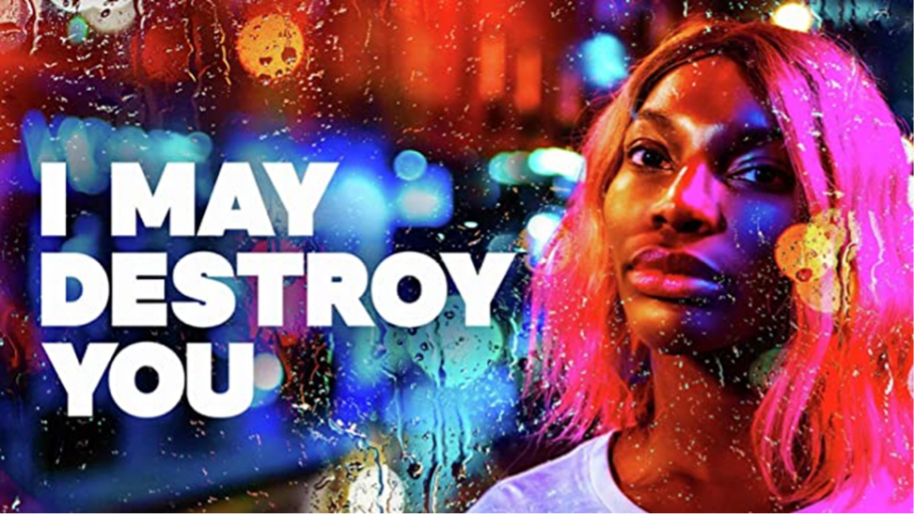This text is licensed under the Creative Commons license Attribution-NonCommercial-ShareAlike 4.0 International. The link to the original material is situated at the top right of the text.

Source: https://cdn.bfldr.com/SH6M70M3/as/8rqhnnm5wgjnx4x6khxcrgb/i_may_destroy_you_imagejpg_by_FALKNA_Productions_and_HBO
TV Miniseries
Keywords: intersectional feminism, LGBTQIA+
Threads: Cooperating with(in) arts and culture
I May Destroy You
Michaela Coel
2020
Keywords: intersectional feminism, LGBTQIA+
Threads: Cooperating with(in) arts and culture
Short description
I May Destroy You is a sublime, multi-layered drama miniseries about sexual consent and empowerment of (queer) millennials of color written by, starring and in part directed by Michaela Coel.
Coel plays Bella, an aspiring talent in the literary world. When her drink is spiked while partying and the violence, she subsequently experiences does not manifest itself in her memory, but only through temporary flashbacks and the marks on her body, she becomes more aware than ever of her vulnerability as a woman in a patriarchal society. By means of social media and literary reappraisal, she finds a very empowering way of dealing with her experience of abuse for herself and her numerous readers and viewers.
Coel plays Bella, an aspiring talent in the literary world. When her drink is spiked while partying and the violence, she subsequently experiences does not manifest itself in her memory, but only through temporary flashbacks and the marks on her body, she becomes more aware than ever of her vulnerability as a woman in a patriarchal society. By means of social media and literary reappraisal, she finds a very empowering way of dealing with her experience of abuse for herself and her numerous readers and viewers.
Personal appreciation
Still a rare example of art that challenges patriarchy and the violence this dominant system produces in everyday life from a Black FLINTA (and in parts queer) perspective. Especially in a mainstream context, I May Destroy You being a big budget TV series production by BBC and HBO, written, produced and directed by a Women of Color, is unfortunately an exception. Other current examples of Women of Color creating widely received TV show are e. g. Ava DuVernay (When They See Us) or Janet Mock (Pose).
Contribution to the "Who knows?" handbook
A series by subaltern bodies themselves, about them, their struggle with structural discrimination and violence, their joy and desire, their re-empowerment – telling and producing their own narratives out of their own community and milieu.
Material(s)
Link to material #1 - (Youtube video, 53 mins)
Talk: Michaela Coel | James MacTaggart Lecture | Edinburgh TV Festival 2018
Michaela Coel during her James MacTaggart Lecture on turning down a million dollar deal with Netflix to preserve full creative control and ownership rights of her project.
Talk: Michaela Coel | James MacTaggart Lecture | Edinburgh TV Festival 2018
Michaela Coel during her James MacTaggart Lecture on turning down a million dollar deal with Netflix to preserve full creative control and ownership rights of her project.
Additional Information
| Location | United Kingdom |
| Original language(s) | English, Italian, Twi |
| Existing translations | |
| Length | 368 mins, 12 episodes |
| Project runtime | - |
| Institution of affiliation | BBC, HBO |
| Sponsor(s) |
Name of contributor: Samuel Döring
Additional Pictures
Creative Commons
Related Contributions

Conference
Kenny Fries, Sanni Est, Miriam Camara, Rhea Ramjohn
Roundtable: Undoing Discrimination? Diverse in Berlin?
Kenny Fries, Sanni Est, Miriam Camara, Rhea Ramjohn
Moderation: Samie Blasingame
2021
Are diversity measures in cultural institutions just another set of methods of solidifying what they claim to change? What are the inconspicuous formal routines, the small informal habits, the official and unofficial rules that create the feeling of running into a wall that one claims is not there?

Text
Can the Subaltern Speak?
Gayatri Chakravorty Spivak
1988
“Can the subaltern speak? What must the elite do to watch out for the continuing construction of the subaltern?” (p. 294).







